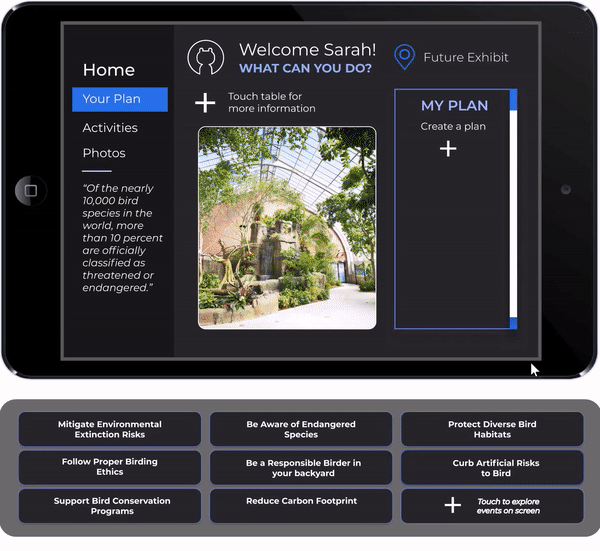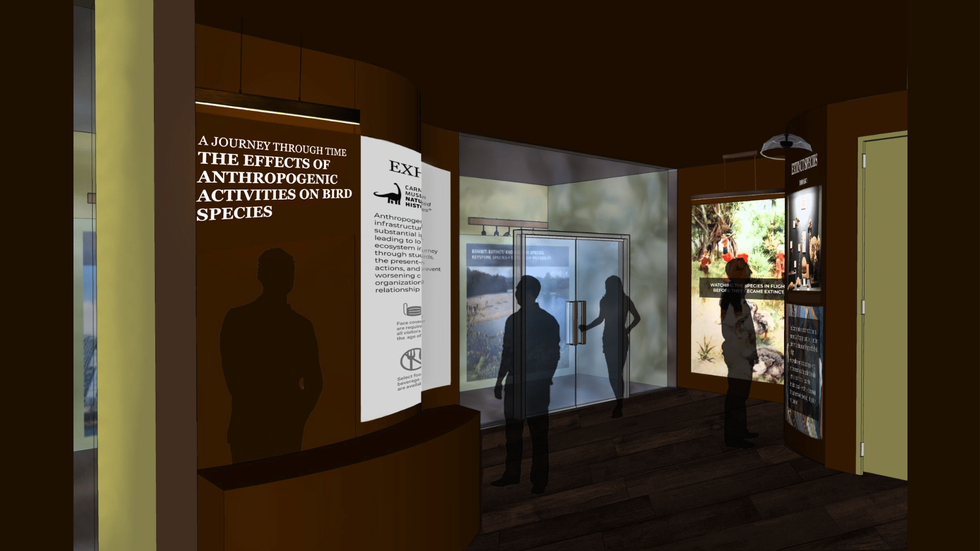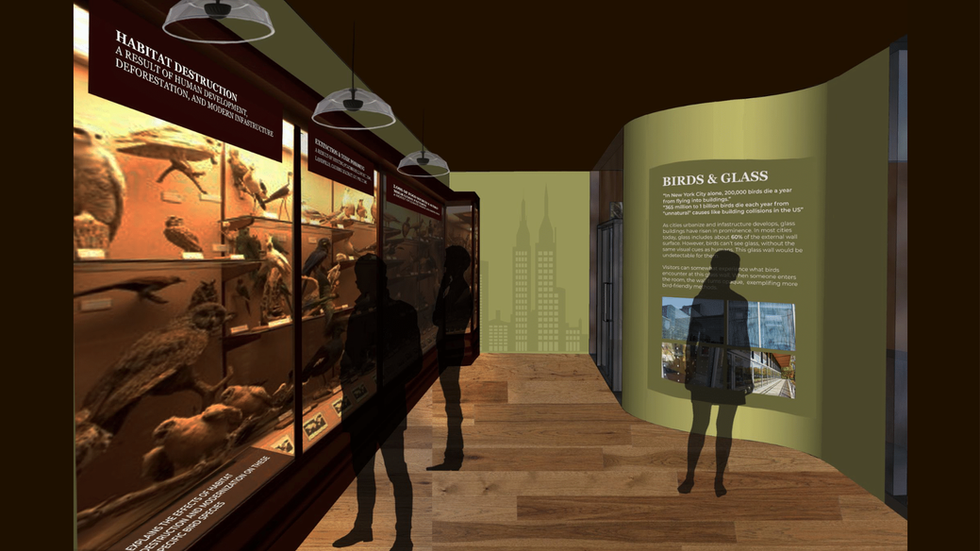Hybrid Museum Exhibit
The Effects of Anthropogenic Activities on Bird Species
Environment Design
4 Week Environments Studio Project
My Project Goal
Designing a hybrid museum exhibition that travels through time, using technological interactions to enhance the visitor’s experience
Final Concept
Anthropogenic activities including deforestation, growing infrastructure, manufacturing, and hunting have had substantial impacts on bird species throughout the world, leading to loss of biodiversity, habitat destruction, and ecosystem instability. This hybrid exhibit takes you on a journey through studying the past—the infamous extinctions of birds, the present— understanding causes and effects of human actions, and the future—including actions you can do to prevent worsening conditions for bird species and environmental organizations to support. Representing the Carnegie Museum of Natural History, the exhibit allows visitors to better understand the changing relationship between humans and birds all around us.
Tools
3D-Rendering: SketchUp
Physical Modeling: Foamcore, Acrylic Glass, Paper, Box Cutter, Hot Glue
Elevations/ Floor Plans: CAD Tools, Figma
Digital Computing: Arduino (C+), Animation
Illustrations: Illustrator, Photoshop
Presentation: Indesign, Photoshop, Figma
Chosen Client
Carnegie Museum of Natural History
Target Audience
Students and faculty in the Oakland area
Location
Miller Institute of Contemporary Art
(Access project components through side navigation bar)
.png)
.png)
.png)
Site Research
Initial Site Exploration | Miller Institute of Contemporary Art
Visited the Miller Institute to understand the size and space of my target location, options for lighting changes, wall placement, and flooring.

Observations
.png)
Visiting the Client | Museum of Natural History
View what existing exhibits depict the Anthropocene and narrowed down 3 potential issues to discuss
Human energy consumption of fossil fuels and other non-renewable resources have large impacts on the environment (air pollution, global warming, rising temperatures, and sea levels etc); Deforestation leading to decreasing biodiversity
Idea 1: Energy Consumption

Anthropogenic activities have led to decreasing biodiversity, impacting the stability of ecosystems — deforestation, growing infrastructure and construction, and hunting throughout history has led to the extinction of several bird species
Idea 2: Impact on Bird Species

Emphasize how human emissions (anthropogenic activities) cause rising sea levels, melting glaciers, changing geology (climate change) significantly more than tectonic plates, and volcanic processes/ emissions (natural processes) do.
How poor mining practices across the world contribute to erosion, sinkholes, deforestation, decreasing biodiversity, and significant use of water resources, degrading the environment.
Idea 3: Geologic Effects

Moodboard
I chose a color palette shifting from olive greens to brown to represent the natural environment, invoking an innate sense of sanctity and peacefulness. The somber, pastel colors are also intended to emotionally appeal to the audience, combined with displaying bird species that have become extinct due to human activities, making them more inclined to take action. These colors also depict the habitats of many bird species— juxtaposing their actual environment (ie. the tropical rainforest) within this artificial space.


The top right image of a living room captures the clean, modern feeling I want the exhibit to embody, especially with see-through glass walls/ windows (similar to windows that birds typically run into) to exemplify how human construction has negatively affected the daily lives of birds. The top middle image is from the Carnegie Museum, where green is used as an accent color for their exhibit signage and text, and harsh lighting is used on their display cases. The main serif font is synonymous with the rustic feel of the dark brown wood grain, fitting the more serious and formal tone of the exhibit.I chose smooth dark brown wood patterns for the ground of the exhibit — laminate (fake wood) texture — to ironically play on how deforestation harms birds, and humans excessively use these materials. Being inside the exhibit will force people to face this issue head-on.
Storyboard
Drew an intitial storyboard of the user's experience through the space. Refined the interactions throughout the process


CAD Elevations & Floorplans
.png)
.png)

I created elevations and floor plans according to the layout of Miller Gallery, and began to develop content for the walls of the exhibition.
Developed the final layout including decisions about the present, past, future exhibits.
PARTI Diagrams: Refining Concept & Interactions

Previous Iterations

.png)
Final Iterations
SketchUp Model: Rendering the Space
Understood proportions and realistic nature of my proposed exhibit in 3D space through SketchUp Modeling

Arduino Prototyping: Coding the Interactions (C+)


Arduino Diagram outlining the interaction when a visitor approaches within 2 feet of the exhibit and the ultrasonic distance sensor turns on a series of LED lights (Phillips Hue: exhibit lights for the corresponding display) and plays a sound (Localized sound domes: bird calls)
There is a physical component of the same interaction. Localized sound domes allow visitors to hear bird calls associated with the extinct animal. The display case smart lights turn on with Philips Hue, controlled wirelessly. The lights and sound domes are integrated through an Ultrasonic Distance Sensor which measures the time between sending and receiving pulses of sound waves to determine the distance
Other Technological Interactions

32" Single Localizer Sound Dome
Audio isolation, Stereo quality audio, Provides a listening experience similar to headphones for an individual listener.
Philips Hue Smart LED/ strips — lights based on proximity
Controlled wirelessly, The Phillips Hue line of bulbs was the first smart bulb of its kind on the market, Illuminates the display case by motion
Ultrasonic Distance Sensor
Connected to lights and sound to detect visitors within 2 feet; Sends out a sound wave at a frequency above the range of human hearing; Determines distance by measuring time lapses between the sending and receiving pulses
Electrochromic Glass
When a visitor enters the present exhibit, the electrochromic glass turns from transparent to opaque
Opaque State: Applying a low voltage of electricity when the door is closed, the glass darkens coating the lithium ions and electrons transfer between electrochromic layers.
Clear State: The polarity is reversed, causing the ions and electrons to return to their original layers.
Inspired by the “The Tokyo Toilet Project”
Interface Animation: Demonstrate Part 3: The Future Exhibit
Visitors can interact with the interactive tabletop device which sends information to the screen above it through casting over wifi. Calling them to action, visitors can select relatable ways they can contribute to preventing the worsening of bird extinction in their community and add actions to their plan, which is displayed on the screen with associated pictures.

Physical Model: Understanding the Space
Materials: Foam Core, Paper, Acrylic Glass, Clear Bars, Construction Paper, Hot glue
Grasp 3D space by crafting a physical model of the exhibit with foam core, paper, and hot glue. Placed miniature figures to consider scale, realizing that several of my designs were too high up to be easily readable.

Researching & Writing Exhibit Content
Researching about bird extinction and creating material for the walls of my exhibition

Photoshopped Visualizations

Click to expand and read descriptions





































































